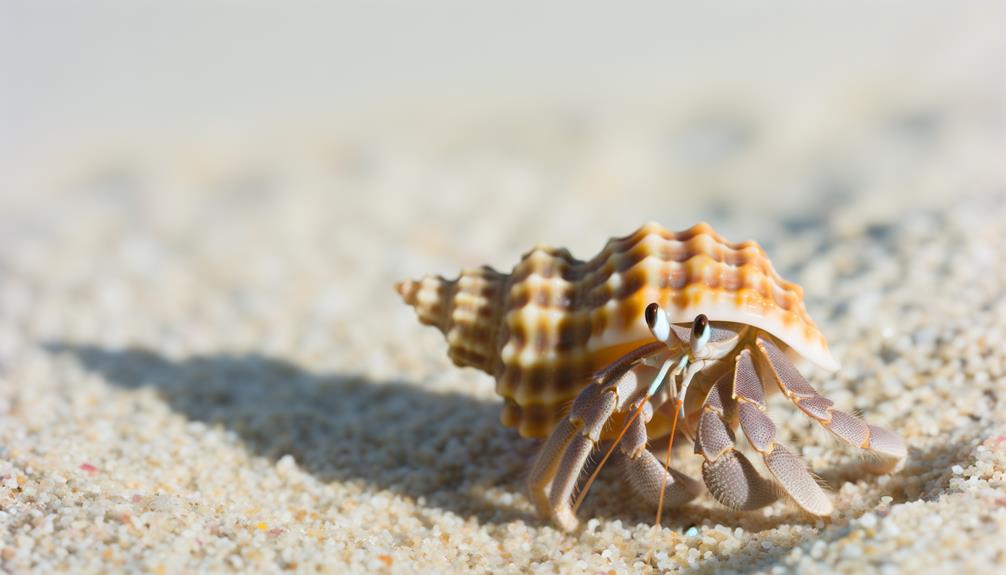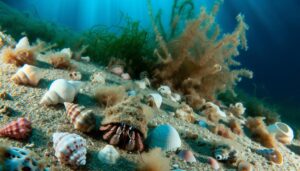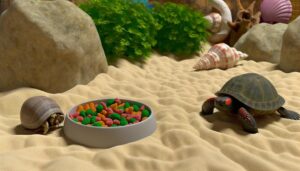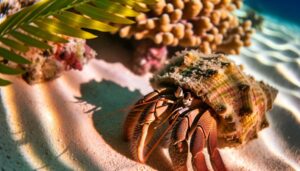Do Hermit Crabs Fight Each Other?
Yes, hermit crabs do feel pain. They exhibit nociceptive responses, meaning they have sensory neurons called nociceptors that detect harmful stimuli.
When you see a hermit crab retract into its shell or switch shells, this behavior can indicate discomfort or pain. Studies show they share neural pathways and behavioral responses suggesting pain perception similar to other invertebrates.
Understanding their anatomy and responses guarantees better welfare standards and treatment practices. If you're intrigued by how to care for them humanely and secure their wellbeing, there's much more to discover about their needs and behaviors.

Key Takeaways
- Hermit crabs have nociceptors to detect harmful stimuli, indicating they can feel pain.
- Behavioral responses like retraction into shells suggest discomfort or pain in hermit crabs.
- Studies show hermit crabs exhibit both behavioral and physiological signs of pain.
- Neural pathways in hermit crabs transmit pain signals to their brain, confirming pain perception.
- Ethical treatment of hermit crabs is crucial to minimize their suffering in research and pet care.
Understanding Hermit Crab Anatomy
To understand how hermit crabs experience pain, you need to first explore their unique anatomical structure, including their exoskeleton, soft abdomen, and sensory organs.
The exoskeleton serves as a protective outer shell, essential for defense against predators and environmental hazards.
Unlike other crabs, hermit crabs possess a soft, coiled abdomen, which they protect by inhabiting empty shells.
Sensory organs, like compound eyes and antennae, enable them to detect environmental changes and potential threats.
These anatomical features not only facilitate their survival but also play a role in their response to noxious stimuli.
Pain Perception in Invertebrates
Frequently debated in scientific circles, pain perception in invertebrates continues to challenge our understanding of animal sentience and welfare. You might wonder how these creatures experience pain, given their simpler nervous systems. Research suggests nociception, the sensory nervous system's response to harmful stimuli, is present in many invertebrates, indicating a capacity for pain-like experiences.
Behavioral studies show reactions such as escape responses and protective behaviors, implying a subjective experience of discomfort. Ethical implications arise, urging you to contemplate humane treatment standards for invertebrates. Recognizing their potential for pain can influence decisions in research, pet care, and wildlife conservation, emphasizing the importance of compassion and empathy in our interactions with all living beings.
Neural Pathways in Hermit Crabs
In hermit crabs, the neural pathways involved in pain perception are remarkably complex, revealing sophisticated mechanisms despite their simpler nervous systems. You'd find that these pathways include nociceptors, which are specialized neurons that detect harmful stimuli.
When a hermit crab encounters a potentially damaging stimulus, these nociceptors transmit signals through the central nervous system. The signals travel via afferent neurons to the brain, where they're processed, resulting in the perception of pain. This process is surprisingly similar to how more advanced organisms perceive pain, indicating a level of neural sophistication that supports their well-being.
Understanding these pathways helps you appreciate the importance of humane treatment and the need for further research into invertebrate pain management.
Behavioral Responses to Stimuli
You're observing how hermit crabs exhibit distinct behavioral responses to noxious stimuli, such as withdrawal from perceived threats and alterations in shell selection.
When exposed to harmful conditions, they rapidly retract into their shells, demonstrating a clear pain response.
Additionally, they prioritize choosing shells that minimize discomfort, indicating an adaptive behavior driven by pain avoidance.
Withdrawal From Threats
Observing hermit crabs, you'll notice they promptly withdraw into their shells when exposed to potential threats, demonstrating a clear behavioral response to stimuli. This immediate retreat suggests an acute sensitivity to environmental changes.
When exposed to noxious stimuli, such as sharp objects or sudden light, hermit crabs exhibit a rapid retraction into their shells, a behavior known as thigmotaxis. This response serves as a protective mechanism, minimizing potential harm.
By withdrawing, hermit crabs reduce their exposure to predators and damaging conditions. This behavior indicates their capacity for nociception—the ability to detect and respond to painful stimuli.
Understanding these responses helps in creating better care environments, ensuring their well-being and minimizing stress, thereby serving their needs effectively.
Shell Selection Changes
How do hermit crabs' shell selection behaviors adapt in response to environmental stimuli and potential threats?
You'll notice that hermit crabs exhibit highly selective behaviors when choosing new shells, showing preference for those offering best protection and mobility.
When exposed to physical damage or chemical cues indicating predator presence, hermit crabs often abandon suboptimal shells for more secure options. They prioritize shell integrity and fit, indicating a sophisticated pain response mechanism.
Crabs have been observed inspecting potential shells meticulously, tapping and turning them to assess suitability. This indicates that their shell selection isn't random but a calculated response to environmental pressures, showcasing their ability to adapt to threats and ensuring their survival and well-being.
Studies on Nociception
Recent research into nociception reveals that hermit crabs exhibit complex behavioral and physiological responses indicative of pain perception. These studies show that hermit crabs can detect and respond to harmful stimuli, an essential aspect of evaluating pain.
Researchers have identified several key behaviors and physiological changes in hermit crabs when exposed to noxious stimuli:
- Behavioral Withdrawal: Hermit crabs often retract into their shells or abandon them entirely when exposed to harmful conditions.
- Physiological Stress Markers: Elevated heart rates and stress hormone levels are observed, indicating a systemic reaction to pain.
- Long-term Avoidance: Hermit crabs display learned avoidance of areas where they previously encountered painful stimuli, suggesting memory and adaptive behavior.
These findings highlight the importance of considering welfare in hermit crab care.
Comparing With Other Crustaceans
When comparing hermit crabs to other crustaceans, you should consider the presence of pain receptors and the behavioral responses observed. Research indicates that various crustaceans, including crabs and lobsters, possess nociceptors, suggesting a potential for pain perception.
Additionally, behavioral studies show that these species often exhibit avoidance and protective behaviors when exposed to harmful stimuli.
Pain Receptors Presence
In examining the presence of pain receptors, or nociceptors, in hermit crabs, it's crucial to compare their neural structures with those of other crustaceans like lobsters and shrimp. Hermit crabs possess nociceptors that are structurally similar to those found in other crustaceans, indicating a shared capacity for pain perception.
Studies have highlighted several key aspects:
- Neural Pathways: Hermit crabs have intricate neural pathways that transmit nociceptive signals, akin to lobsters and shrimp.
- Neurotransmitters: The presence of neurotransmitters such as glutamate and substance P, involved in pain transmission, is confirmed in hermit crabs.
- Behavioral Correlations: Anatomical evidence aligns with specific behavioral responses to noxious stimuli, suggesting functional nociception.
Understanding these similarities enhances our ability to serve and protect these creatures.
Behavioral Responses Observed
Comparative analysis of behavioral responses to noxious stimuli reveals that hermit crabs, much like lobsters and shrimp, exhibit defensive and avoidance behaviors indicative of nociception. You can observe hermit crabs withdrawing into their shells or abandoning them entirely when exposed to harmful stimuli, similar to how lobsters and shrimp react to threats by retreating or tail-flipping. These responses suggest an ability to detect and react to pain.
Additionally, hermit crabs show prolonged grooming or rubbing of affected areas, paralleling behaviors seen in other crustaceans. These actions indicate a sophisticated pain response mechanism. Understanding these behaviors not only advances our scientific knowledge but also informs more humane practices in handling and care, recognizing the potential for suffering in these creatures.
Ethical Implications of Findings
Recognizing that hermit crabs feel pain introduces significant ethical considerations for their treatment in both scientific research and commercial industries. You must evaluate and adjust practices to minimize suffering.
- Regulatory Compliance: Ensuring adherence to animal welfare laws that now account for invertebrate pain perception.
- Research Protocols: Developing humane experimental methods that prioritize analgesia and stress reduction.
- Commercial Practices: Reforming pet trade and aquarium management standards to provide appropriate care and habitat conditions.
Improving Hermit Crab Welfare
To enhance hermit crab welfare, you must implement evidence-based practices that address their specific physiological and psychological needs. Start by ensuring a habitat that mimics their natural environment, providing appropriate humidity levels (70-80%) and temperatures (75-85°F).
Use substrates like coconut fiber or sand to facilitate burrowing, a critical behavior for stress reduction. Offer a variety of shells to accommodate growth and prevent shell fights.
Nutrition should include a balanced diet rich in calcium and protein. Social enrichment is also crucial; consider maintaining multiple crabs to mimic natural social structures.
Regularly monitor for signs of stress or illness, and consult a veterinarian with expertise in crustaceans. Your effort can greatly improve their quality of life.
Common Misconceptions
Many people mistakenly believe that hermit crabs are low-maintenance pets that require minimal care. This misconception can lead to inadequate living conditions and increased stress for these crustaceans. Hermit crabs actually have specific needs that must be met to ensure their well-being.
- Shell Selection: Hermit crabs require a variety of shells to choose from, as they periodically need to switch to larger shells for growth.
- Humidity Levels: Maintaining proper humidity is essential; without it, hermit crabs can suffer respiratory issues.
- Social Interaction: These creatures are social and thrive in groups, so isolation can lead to significant stress.
Understanding these facts will help you provide a more humane and enriching environment for your hermit crabs.
Practical Care Tips
To guarantee your hermit crabs thrive, you must maintain ideal habitat conditions and provide a proper diet. Keep the humidity between 70-80% and temperature around 75-85°F to mimic their natural environment.
Additionally, offer a balanced diet that includes commercial hermit crab food, fresh fruits, and vegetables to meet their nutritional needs.
Optimal Habitat Conditions
How can you ensure that your hermit crabs thrive? Ensuring prime habitat conditions is crucial. Maintain a stable environment by regulating temperature and humidity. Aim for a temperature range of 75-85°F and humidity levels between 70-80%.
Offer a spacious tank with various substrates such as sand and coconut fiber to replicate their natural habitat.
- Temperature Regulation: Use a thermometer and heat mat to maintain the ideal temperature.
- Humidity Control: Employ a hygrometer and mist the tank regularly to maintain proper humidity levels.
- Enrichment: Provide climbing structures, hiding spots, and a variety of shells to encourage natural behaviors.
Proper Diet Choices
What should you feed your hermit crabs to guarantee they receive a balanced diet rich in essential nutrients?
You'll want to provide a mix of fresh fruits, vegetables, and protein sources. Fresh fruit options include apples, pears, and bananas, while vegetables like spinach and carrots offer essential vitamins. For protein, consider boiled eggs, fish, or commercial hermit crab food.
Calcium is important for shell health; supplement their diet with crushed eggshells or cuttlebone. Avoid processed foods and those high in salt or sugar.
Consistently vary their diet to mimic their natural scavenging behavior. Providing a well-rounded diet ensures your hermit crabs thrive, supporting their overall well-being and longevity.
Conclusion
You've explored the intricate anatomy, neural pathways, and behavioral responses of hermit crabs.
You've examined the scientific studies on nociception and the ethical implications of the findings.
Now, it's evident: hermit crabs do experience pain. With this understanding, you can enhance their welfare through informed care practices.
Dispelling common misconceptions, you can guarantee their well-being.
Hermit crabs aren't just simple creatures; they're sentient beings deserving of thoughtful, compassionate care.






